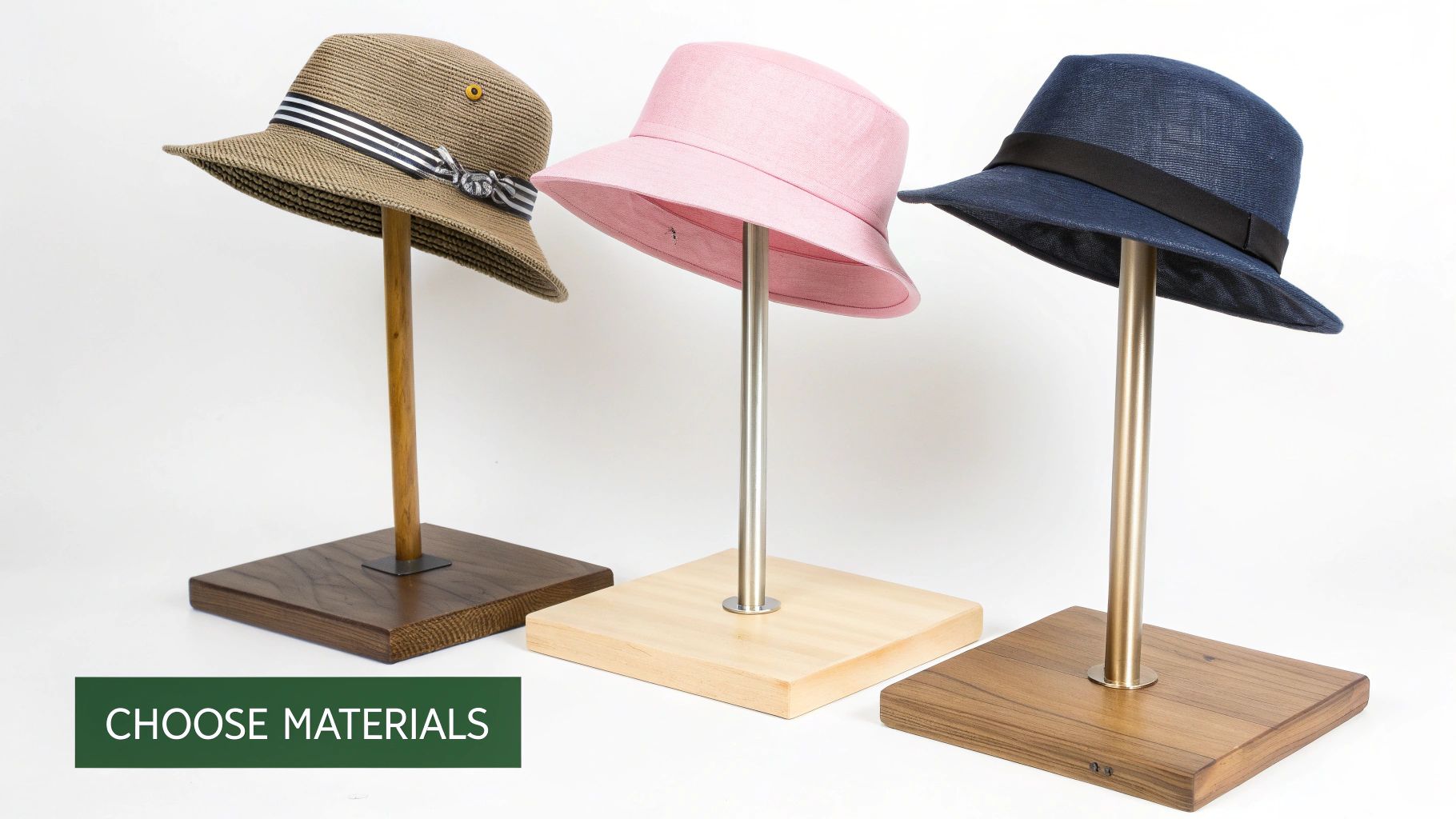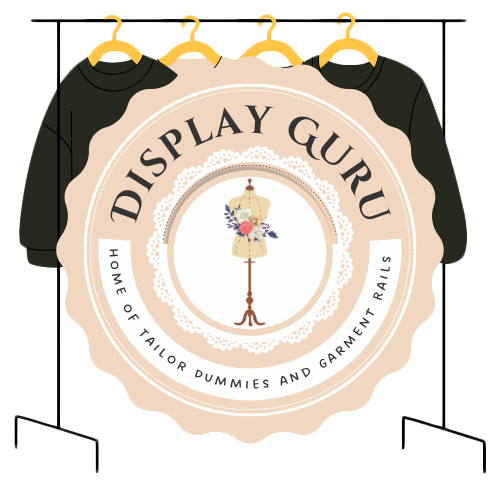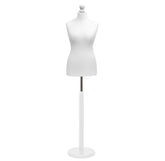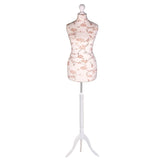Choosing Display Stands for Hats
The right display stands for hats do more than just hold headwear. They’re the silent storytellers that preserve a hat’s shape, show off its best features, and turn a simple product into something truly desirable. A well-chosen stand is what separates a cluttered pile from an elegant, curated collection.
Why Your Hat Display Matters More Than You Think
Let's be honest, staring at a jumble of hats can feel a bit chaotic, whether you're a collector at home or a customer in a shop. A thoughtful display brings order, but its real power is in changing perception. Think of it like a jeweller using a velvet bust to showcase a necklace—the stand provides context and instantly elevates the item it holds.
This is the fundamental art of presentation. A hat perched on a beautifully crafted wooden stand immediately looks more valuable than one crammed onto a busy shelf. It’s not just about being tidy; it’s about shaping the narrative around your products or your personal collection.
For retailers, the advantages are crystal clear:
- Boosts Perceived Value: Professional displays signal quality and care, which can justify better pricing and strengthen your brand's position.
- Improves the Customer Experience: An organised display lets shoppers browse styles, compare options, and find what they want without getting frustrated.
- Enhances Brand Storytelling: The style of your stands—whether rustic wood or sleek, modern metal—is a key part of your brand’s identity and aesthetic.
“A display stand is the silent salesperson for every hat in your collection. It communicates quality, style, and care before a customer even touches the product.”
The Rich History of British Millinery Displays
The importance of a good hat display is woven deep into British retail history. Back in the early 20th century, when a hat was an essential part of any outfit, millinery shops across the UK used elegant, often tall, wooden stands to show off the latest cloches and elaborate designs.

The design of these stands evolved right alongside fashion itself, a story beautifully captured by institutions like the Stockport Hat Works Museum. It’s fascinating to note that visitor numbers to the museum shot up by over 25% in the decade following the 2011 Royal Wedding, which sparked a renewed public interest in traditional British millinery and how it’s presented.
This slice of history proves that while styles come and go, the core principles of great presentation never change. If you're looking for broader inspiration, you can explore some excellent general store display ideas that really focus on engaging with customers. Getting these basics right is a huge step, and you can dive deeper with our practical tips in our guide on visual merchandising: https://www.displayguru.co.uk/blogs/news/visual-merchandising-guidelines.
Selecting the Right Material for Your Hat Stands
Choosing the material for your display stands for hats is a bit like picking the perfect frame for a piece of art. The frame doesn't just hold the picture; it complements it, sets the mood, and helps tell the story. In the same way, swapping a rustic wooden stand for a polished chrome one can completely change how a customer sees the hat sitting on it.
But this isn't just about looks. The material you pick has a direct impact on durability, how much maintenance is needed, and whether the stand feels at home in its surroundings—be that a busy shop floor or a quiet corner of your bedroom. It’s all about finding that sweet spot between form and function.

Wood: The Classic and Timeless Choice
There's a certain warmth and timeless elegance to wooden hat stands that other materials just can't replicate. Picture a traditional British milliner or an upmarket boutique—the deep grain of an oak stand or the clean finish of pine instantly suggests quality and craftsmanship. Wood is also incredibly adaptable, looking just as good in a rustic, vintage-themed display as it does in a modern, minimalist one.
Because it's a natural material, wood does need a little TLC. Keeping it out of direct sunlight will prevent the colour from fading, and an occasional polish with a good wood cleaner will keep it looking its best. A small price to pay for such a classic look.
Metal: For a Modern, Industrial Edge
If you're after a look that’s sharp, contemporary, and effortlessly cool, metal is the way to go. Materials like chrome, stainless steel, or matte black steel give off an industrial-chic vibe that works brilliantly with modern fashion and urban brands. Metal stands are also famously durable and stable, making them a solid investment for high-traffic retail spaces.
Their clean, simple lines ensure that the hat remains the main attraction. While they are built to last, metal surfaces can show up fingerprints and dust, so a quick wipe with a microfibre cloth now and then will keep them looking pristine.
Think of your stand’s material as a silent salesperson. Wood whispers quality and tradition. Metal projects strength and modernity. And acrylic? It lets the hat be the undisputed star of the show.
Acrylic: The Invisible Hero
When you want nothing to distract from the hat itself, acrylic is your best friend. These clear stands are practically invisible, creating a striking illusion of floating headwear. The result is a clean, uncluttered display that really lets the design and colour of your hats pop.
Acrylic is also lightweight and generally quite affordable. The trade-off is that it needs careful handling, as it can scratch or scuff. It also tends to attract dust, so a gentle clean with a soft cloth and a proper plastic cleaner is key to keeping that crystal-clear finish. If you want to explore how different materials can shape a retail environment, our guide on display stands for clothing has some great transferable tips.
Fabric-Covered Mannequins: For Realistic Context
Let's be honest: sometimes a hat just needs a "head" to look right. Fabric-covered mannequin heads, often finished in linen, velvet, or canvas, show customers exactly how a hat is meant to be worn. This is absolutely essential for styles like cloches, beanies, and fascinators, where the fit and angle are everything.
The texture of the fabric itself can also add a touch of luxury.
- Linen: Gives a fresh, natural feel that’s perfect for spring and summer collections.
- Velvet: Adds a sense of opulence, making it ideal for formal hats or winter wear.
- Canvas: Offers a tough, neutral backdrop that works well for almost any style.
These stands give shoppers a real sense of what the hat will look like on, helping them make that final decision. A bit of light dusting or a gentle vacuum with a brush attachment is all it takes to keep the fabric looking sharp.
Comparing Common Hat Stand Materials
To make your decision a little easier, we’ve put together a quick comparison of the most popular materials. Your choice will ultimately come down to the look you’re aiming for, your budget, and how the stands will be used day-to-day.
| Material | Aesthetic | Durability | Best For | Average Cost |
|---|---|---|---|---|
| Wood | Classic, Warm, Natural | High | Boutiques, heritage brands, home collections | Moderate |
| Metal | Modern, Industrial, Sleek | Very High | Contemporary retail, minimalist spaces | Moderate to High |
| Acrylic | Minimalist, Unobtrusive | Moderate | Highlighting colourful hats, modern displays | Low to Moderate |
| Fabric | Realistic, Soft, Textured | Moderate | Showing fit, luxury or soft hat styles | Moderate |
Each material brings something different to the table. By matching the material's character to your brand and your hats, you can create a display that doesn't just show off your products—it enhances them.
Navigating the Different Types of Hat Displays
Just as a hat is more than a simple accessory, a display stand is more than just a hook to hang it on. The stand you choose fundamentally shapes how a hat is seen, making it vital to pick a style that aligns with your goals. The truth is, not all display stands for hats are created equal; each type has a specific job, whether it's spotlighting a single masterpiece or organising an entire collection.
Your journey into the world of hat displays starts with the most common and practical options. Think of these as the workhorses for both retail shops and home collectors, offering simple but powerful ways to present headwear. Getting to grips with these foundational choices is the first step towards creating a display that’s as functional as it is visually appealing.
The Foundational Choices: Countertop and Mannequin Displays
The single countertop stand is probably the most classic option you'll find. It’s the equivalent of a spotlight on a stage, designed to elevate one special hat and make it the centre of attention. These stands, often featuring a simple dome or abstract shape, are perfect for highlighting new arrivals or bestsellers in a shop. For a home collector, it's a brilliant way to feature a "hat of the week" on a dresser or shelf.
Then you have mannequin heads, which take the presentation to a whole new level by adding that all-important context. A hat sitting on a mannequin head isn't just an object anymore; it’s an accessory being worn. This is invaluable for showing customers exactly how a beanie should slouch or how a fascinator sits at that perfect angle. It offers a realistic preview that helps bridge the gap between just seeing the hat and actually imagining it on.
Mannequin heads are essential for a complete presentation. They don't just hold the hat; they give it life and form, answering the customer's silent question: "How would this look on me?"
These displays are so effective because they immediately engage a customer’s imagination. For a deeper dive, you can explore the benefits of using a head mannequin stand and see how it can transform your visual merchandising. Of course, when thinking about displays, you also need to consider the hats themselves, like the various styles of golf hats, as each one might need a unique solution.
Expanding Your Display Horizons: Multi-Arm and Wall-Mounted Options
Once you move past displaying single items, you'll need solutions that can handle more volume without creating clutter. This is where multi-level and space-saving designs really shine, offering the versatility needed for growing collections and dynamic retail floors.
A multi-arm stand, often called a hat tree, is a fantastic way to showcase a coordinated collection in a compact footprint. It cleverly uses vertical space to display several hats at once, letting you group items by colour, style, or season. A retailer, for instance, might use a three-arm stand to present a fedora in black, grey, and navy, making it incredibly easy for a shopper to compare their options.
On the other hand, wall-mounted displays are the ultimate space-savers. These can range from simple, individual hooks to more complex, modular systems.
- Individual Hooks: Perfect for creating an artistic, scattered display on a feature wall. They’re minimalist and put the entire focus on the hat itself.
- Slatwall or Gridwall Fixtures: These offer unparalleled flexibility. With specialised hat holder attachments, you can completely change your layout in minutes, making them a firm favourite in retail environments where displays need constant refreshing.
These systems let you turn an empty wall into a functional and eye-catching gallery of headwear. They’re especially useful in smaller boutiques or walk-in wardrobes where every square inch of floor space is precious.
Matching the Stand to the Hat Style
The final piece of the puzzle is making sure the stand you choose is the right fit for the specific type of hat you're displaying. The wrong stand can distort a hat’s shape over time or just fail to show it off properly. This isn't just about looks; it's about proper care and preservation.
For delicate or wide-brimmed hats—think sun hats or formal occasion wear—the stand needs to provide plenty of support and clearance. A stand with a tall base is a must to prevent the brim from resting on the surface, which can cause it to warp and lose its elegant shape.
Conversely, soft, unstructured hats like beanies or berets need a stand that can give them some form. A simple dome or a full mannequin head is ideal here, as it fills out the hat and shows it as it would look when worn. A simple hook would just leave a beanie looking like a limp piece of fabric, failing to communicate its style at all.
Structured hats like fedoras, trilbies, and boaters require a head form that supports the crown without stretching the band. A slightly undersized mannequin head often works best, ensuring the hat rests securely without putting any stress on the material. Thinking through these pairings ensures every hat in your collection is presented in the best possible light.
Creating Visually Stunning Hat Arrangements
So, you’ve picked out the perfect display stands for hats. That’s a great start, but it's only half the battle. The real art lies in how you arrange them, turning a simple collection of hats into a display that genuinely stops people in their tracks. This is where a little retail merchandising savvy comes in, and the good news is, these principles are surprisingly easy to apply, whether you're dressing a shop window or just organising your collection at home.
The aim is to build a display that doesn't just look professional but also tells a story. You want to guide the viewer’s eye, spark their curiosity, and create a little bit of magic. By thinking carefully about hierarchy, balance, colour, and spacing, you can craft an arrangement that feels both deliberate and effortlessly stylish. It’s about moving beyond just putting hats on stands and starting to curate an experience.
Establish a Clear Visual Hierarchy
The first step to creating an engaging display is to build a clear visual hierarchy. Think of yourself as a film director—you need to tell your audience exactly where to look first. The simplest and most effective way to do this is by playing with the heights of your display stands.
An arrangement where every stand is the exact same height can quickly look flat, boring, and monotonous. But when you start mixing tall, medium, and short stands, you create a dynamic landscape that encourages the eye to dance around the display. This technique naturally pulls attention towards certain pieces, making it an brilliant way to highlight your bestsellers or brand-new arrivals.
"A well-designed display should have a rhythm. By using stands of varying heights, you create peaks and valleys that guide the customer’s eye across the collection, preventing visual fatigue and keeping them engaged."
Try placing your most important hats on the tallest stands to give them immediate prominence. This simple trick establishes a focal point right away and gives the featured item a sense of importance. This visual flow is absolutely crucial for preventing a display from feeling stale. The infographic below breaks down the main types of displays you can use to build out this hierarchy.

As you can see, combining different types of stands is how you create a rich, interesting display that works on multiple levels.
Apply the Rule of Three for Balance
Ever noticed how things grouped in threes just seem more appealing? It’s not your imagination; it's a core design principle known as the rule of three. Our brains are hardwired to find odd-numbered groupings more dynamic and less staged than even-numbered ones.
Putting this into practice is easy. Instead of placing two or four hats together, just try grouping three. For example:
- Create a small cluster of three countertop stands, each at a different height, on a single table.
- Arrange three wall-mounted hooks in a slightly staggered, asymmetrical pattern.
- Use a three-arm stand to show off a few different colours of the same hat style.
This simple principle creates a sense of harmony and balance without making your arrangement feel stiff or predictable. That little bit of asymmetry keeps the display interesting and invites people to take a closer look.
Use Colour Theory and Smart Spacing
Colour is easily one of the most powerful tools in your display arsenal. A well-chosen colour palette can make your entire arrangement pop. You could group hats by similar shades for a cohesive, monochromatic look, or go the other way and use contrasting colours to create bold, eye-catching features. Imagine placing a bright yellow sun hat against a deep blue background—it would stand out instantly.
Just as important is spacing. A cluttered, messy display can overwhelm the eye and, frankly, make the products look cheap. Every hat needs its own "breathing room" to be seen and appreciated properly. Make sure there’s enough space between each stand so that the unique shape and details of every hat are clearly visible. A spacious layout suggests quality and allows each piece to truly shine.
While styling hats is the focus here, many of these ideas apply to other headwear. For more tips, you might find our guide on choosing mannequin heads for wigs useful. By mastering these simple techniques, you'll be able to arrange a display that not only looks stunning but also showcases the unique character of every hat in your collection.
How to Install and Maintain Your Hat Stands
https://www.youtube.com/embed/WJrwo4Bri28
You've invested in the perfect display stands for hats, but the job isn't quite done. To keep them looking sharp for years to come, a bit of attention to installation and care is essential. Think of it this way: a wobbly stand or a scratched surface can instantly cheapen the look of a beautiful hat, undermining all your hard work.
Getting the setup right from the start is half the battle. For freestanding stands, it's usually as simple as finding a stable, level spot away from the main hustle and bustle where they won't get knocked about. But for anything that needs mounting, a little more effort is required to ensure everything is safe, secure, and perfectly straight.
Secure Installation for Wall and Slatwall Displays
When you're fitting wall-mounted hat holders, stability is paramount. Always, always use the correct wall plugs and screws for your specific wall type—plasterboard needs very different fixings compared to solid brick. A spirit level is your best friend here; even a slightly wonky hook can make an entire display look unprofessional.
If you’re working with slatwall or gridwall systems, the process is generally simpler, but precision still matters.
- Check the Fixture: Before you start, give the backplate a quick once-over to make sure it's clean and undamaged. A bent plate will never sit securely in the groove.
- Insert at an Angle: Tilt the fixture upwards, slotting the top lip into the slatwall groove first.
- Lower and Lock: Gently bring the fixture down until the bottom lip clicks firmly into the groove below. Give it a gentle tug to be certain it's properly locked in.
For anyone tackling a bigger project, like a full feature wall, our guide on installing a wall-mounted hanging rail has some great tips on secure fitting that apply here, too.
Long-Term Maintenance and Cleaning Tips
Regular, simple maintenance is all it takes to keep your stands looking brand new. Just remember that different materials need different kinds of care, so you don't accidentally cause any damage.
“Think of stand maintenance as part of your visual merchandising. A dusty, smudged stand sends the same negative message as a wrinkled shirt on a mannequin. Pristine stands signal quality and attention to detail.”
Here’s a quick rundown on how to clean the most common materials:
- Metal: A soft microfibre cloth is perfect for wiping away dust and fingerprints. For stubborn smudges on polished chrome, a tiny amount of glass cleaner on the cloth works wonders without leaving streaks.
- Acrylic: This material can scratch very easily. Never use paper towels or harsh chemical cleaners. Stick with a soft, lint-free cloth and a cleaning spray made specifically for plastics.
- Wood: Dust regularly with a dry cloth. To bring back its shine, use a good-quality wood polish, always applying it along the grain to enhance its natural lustre.
- Fabric Heads: A lint roller is your go-to for removing dust and stray fibres. For small marks, you can try a slightly damp cloth with a gentle fabric cleaner, but be sure to test it on an inconspicuous spot first.
Finally, one of the best preventative measures you can take is to avoid placing your stands in direct sunlight for long periods. UV rays can cause the colours of both the stand and the hat to fade over time, robbing your display of its vibrancy.
What's New in the World of Hat Displays?
The way we display hats is constantly changing, shaped by fresh retail ideas and what today's shoppers want to see. As hats become less of a simple accessory and more of a style statement, the stands that hold them are getting smarter and more creative. Keeping an eye on these trends is the key to making sure your displays look modern and really connect with customers.
This evolution is happening for a good reason. The UK headwear market is booming—the hat and cap sector alone brought in a massive £400 million in 2022, accounting for over 45% of the market. Experts predict that figure could jump to £750 million by 2030. Unsurprisingly, this has fuelled a huge demand for quality displays. In fact, the number of UK manufacturers making hat stands has grown by 15% in the last five years, with many now designing the versatile, forward-thinking solutions retailers are crying out for. You can get a deeper look at this growth in Grand View Research's UK headwear report.
Sustainability is No Longer an Optional Extra
One of the biggest changes we're seeing is a real push towards sustainable materials. Shoppers are more aware than ever of their environmental footprint, and that includes the fixtures in the stores they love. In response, retailers are actively looking for display stands made from reclaimed wood, recycled metals, or even eco-friendly options like bamboo.
These materials aren't just about ticking an environmental box; they add a completely different feel to your space. A stand crafted from reclaimed timber, for instance, has a warmth and story that you just can't get from mass-produced plastic. It's about making a choice that's both responsible and helps tell your brand's story.
Modular Systems are All About Flexibility
The era of rigid, one-look-fits-all displays is well and truly over. Today's retail environment demands agility, which is why modular display systems are becoming so popular. Whether based on slatwall, gridwall, or customisable pegboards, these setups let merchandisers completely change their hat displays without a major headache.
Think of a modular display system as a set of building blocks for your shop. It gives you the power to adapt to new stock, seasonal promotions, or a new campaign in an instant, keeping your displays fresh without needing a full refit.
This kind of adaptability is essential. It means a store can switch from a packed, collection-heavy layout to a clean, minimalist look for a new launch in just a few minutes. Flexibility isn't a bonus anymore; it's a fundamental part of a successful retail strategy.
Answering Your Hat Display Questions
Even with a solid plan, a few practical questions always pop up when you're setting up a new hat display. Let's tackle some of the most common ones I hear from retailers and collectors to help you get things just right.
How Do I Choose the Right Size Stand?
The golden rule is to match the stand to the hat's structure and how it's meant to sit on a head. For a structured hat like a fedora or trilby, you'll want a mannequin head that's slightly smaller than average – think 21-22 inches in circumference. This gives the hat a snug perch without stretching out the sweatband.
For softer hats, like beanies or cloches, a true-to-size form is better because it shows off their intended shape. And a crucial tip for any hat with a wide brim: make sure the stand is tall enough. You need enough clearance to stop the brim from resting on the counter, which can cause it to warp and lose its shape over time.
Can I Use the Same Stands for Men's and Women's Hats?
Absolutely! The vast majority of display stands for hats are designed to be completely unisex. The real character of the display comes from your styling choices, not the stands themselves.
Sticking with neutral materials gives you maximum flexibility:
- Chrome and Steel: These offer a crisp, modern feel that works for almost any hat style.
- Natural Wood: You can’t go wrong with the classic, warm aesthetic wood provides.
- Clear Acrylic: This is a great choice when you want the hat to be the absolute centre of attention.
While you could choose mannequin heads with more pronounced masculine or feminine features, a simple dome stand is a versatile workhorse that suits everything.
The most effective hat displays are built on versatility. A well-chosen stand in a neutral material will effortlessly showcase everything from a delicate fascinator to a rugged flat cap.
What Is the Best Way to Display Hats in a Small Space?
When space is tight, your best strategy is to go vertical. Wall-mounted displays are brilliant because they free up precious counter and floor space. Look into options like individual pegs or hooks, or even a full slatwall or gridwall system with dedicated hat holders. You can turn an empty wall into a stunning feature.
Another great trick is using a tall, slim hat tree. It creates a lot of visual impact while taking up a tiny footprint. And don’t forget mirrors! Placing them strategically not only makes the area feel more spacious but also lets customers see how a hat looks from every angle without needing to move around much.
At Display Guru, we provide a wide range of high-quality display solutions to bring your vision to life. Explore our collection and find the perfect stands for your hats at https://www.displayguru.co.uk.








